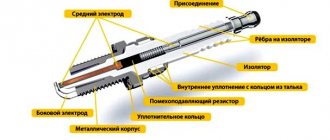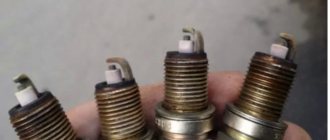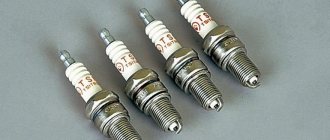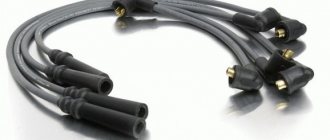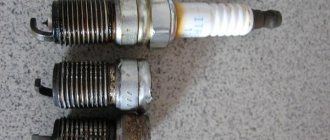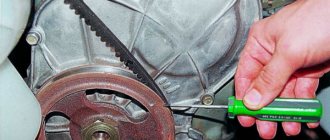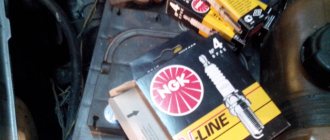Depending on the type of engine, different spark plugs may be installed on the car:
- For engines VAZ 21083-80, VAZ 2110 - A17DVRM, FE65CPR.
- For engines VAZ 2111-16, VAZ 2111-00 - A17DVRM, AC. R42ХLS.
During operation, it is necessary to carry out a routine inspection of the technical condition of the spark plugs on a VAZ 2109 car, cleaning them, adjusting the gap and, if necessary, replacing them. It is also recommended to change candles, regardless of their condition, according to the season - winter and summer.
The spark plugs must be unscrewed one at a time so that during subsequent installation you do not confuse the order of connecting the high-voltage wires. The procedure for checking and adjusting is as follows:
- First of all, you need to de-energize the car by disconnecting the battery.
- Remove the cap from the first spark plug and loosen it, unscrew it from the block head.
As for soot: If the lower part of the spark plug does not have soot or it is weak, then this fact indicates a lean mixture. Light brown uniform carbon deposits are considered normal and do not need to be cleaned. If the spark plug has glossy black soot or soot, this indicates that oil has entered the combustion chambers; such a spark plug must be cleaned.
Cleaning is done using sandpaper and a needle. It is necessary to sand the ends of the electrodes, and use a needle to clean the space between the central electrode and the skirt. Then rinse it in clean kerosene and dry it.
Replace the spark plugs if cracks, chips, or damage to the threaded part are found on the surface of the electrodes.
Now you can start checking and adjusting the electrode gap. The check must be performed only with a special round probe.
For a carburetor engine, the gap should be 0.7-0.85 mm. For an injection engine - 1.00-1.13 mm . To adjust, you need to bend or bend the electrode.
Screw the spark plug into place, having first cleaned the threaded part of the cylinder head from dirt. At this point, the repair work to check the spark plugs on the VAZ 2109 car has been completed.
On a VAZ 2108, VAZ 2109, VAZ 21099 car, the following spark plugs should be used: - for VAZ 21083-80, VAZ 2110 engines - A17DVRM, FE65CPR; - for engines VAZ 2111-16, VAZ 2111-00 - A17DVRM, AS. R42ХLS; To check and replace spark plugs on a VAZ 2108, VAZ 2109, VAZ 21099 car, do the following: 1. Disconnect the wire from the “-” terminal of the battery.
2. Remove the high voltage wire ends from the spark plugs. Clean the spark plug and the area around the spark plug from dirt so that when turning the plug out, no dirt gets into the cylinder.
3. Remove the spark plugs from the cylinder head. 4. Inspect the spark plugs. If the insulators have cracks, threads or electrodes are damaged, the spark plugs must be replaced. Light brown carbon deposits, which evenly cover the bottom of the spark plug with a thin layer, do not affect the operation of the ignition system, and the carbon deposits do not need to be cleaned off. The absence of carbon deposits on the spark plug indicates either that the engine is running on a lean mixture, or that the ignition timing is incorrectly set, or that the spark plug brand does not match the engine type. A shiny black deposit on the spark plug indicates oil has entered the engine cylinder. Such a candle must be cleaned. NOTE Checking the condition of the spark plugs and the engine itself based on the condition of the spark plugs is described in more detail in Section. 3 “Faults along the way”, subsection. “Diagnostics of engine condition by the appearance of spark plugs.”
Checking and installing spark plug gaps in VAZ 2109 – 21099
Almost all spark plugs produced today have a factory-set gap between the electrodes. It is different for each manufacturer. It is also different for spark plugs for carburetor engines with contact and non-contact ignition systems, and for spark plugs for injection engines.
For example, the gaps between the electrodes of spark plugs for VAZ 2109 carburetor engines vary between 0.5-0.7 mm for a contact ignition system, 0.7-0.9 mm for a non-contact ignition system.
Moreover, it is recommended to make the gap smaller by 1 mm in winter, and larger by 1 mm in summer. In this way, improved engine starting and stability of its operation at different atmospheric temperatures are achieved.
It is believed that prolonged cranking of the engine with the starter at low ambient temperatures can discharge even a new battery so much that its voltage is not enough to form a spark if the gap between the electrodes is too large or normal. At the same time, increasing the gap creates additional load on the ignition coil.
For VAZ 2109 injection engines, the gap is in the range of 0.9-1.1 mm. There are no recommendations for changing the gap size for different seasons.
Reasons for replacing elements
The spark plug in any car must function in difficult conditions, solving the following problems:
- promptly ignite the air-fuel mixture compressed in the cylinder;
- provide an even and powerful spark discharge on its contacts;
- sparking should not deteriorate under any engine operating mode.
For ignorant car enthusiasts, checking spark plugs comes down to a “spark” test. This gives rise to an erroneous statement: if, when connected to a source, a spark jumps between the contacts, then the element is in good working order.
But the conditions inside the combustion chamber differ from normal atmospheric ones, since there is high pressure (over 10 Bar), and instead of air there is fuel plus high temperature. Often, a spark plug that produces a reliable spark discharge in air, in the cylinder, works with misfires or does not spark at all.
The operability of the elements can only be determined on a stand with high voltage applied and pressure created in the chamber. Such a check is not available to most ordinary motorists; the only way out is to promptly replace the VAZ 2106 spark plugs by purchasing high-quality products from well-known manufacturers. These include famous brands NGK, Bosch, Beru and Brisk.
Russian spark plugs of the A17 series cannot boast of a long service life and fail after 15-20 thousand kilometers, as evidenced by the following signs:
- The engine "troits". Moreover, sometimes it is impossible to understand which cylinder is failing, since all 4 spark plugs skip ignition cycles.
- The car performs poorly and is unstable until it warms up.
- With high fuel consumption, a drop in power is observed.
- A particularly bad case is when the oil pressure light comes on. This is the result of long-term driving on bad spark plugs, when the fuel that does not burn in the cylinders flows into the crankcase and dilutes the oil, causing its pressure to drop.
Every car enthusiast should remember that if the power unit malfunctions, the first step is to unscrew the spark plugs and visually check their condition.
The color and thickness of carbon deposits on the contacts can tell a lot to an understanding motorist:
- black carbon deposits on the contacts indicate that the fuel in the chamber does not burn completely, perhaps the spark plug has failed;
- a white coating on the electrodes indicates a poor air-fuel mixture, the spark plug is working;
- red carbon deposits indicate that the fuel contains harmful additives; the spark plug is most likely in good working order;
- thick “fluffy” carbon deposits are the result of combustion of oil entering the chamber through the seals or piston group.
The normal color of electrodes is all shades of brown with a minimum thickness of plaque.
Checking the gap between the spark plug electrodes
When installing new spark plugs on an engine or checking old ones, it is necessary to measure the gap between their electrodes. Old spark plugs should be cleaned of carbon deposits. The check is carried out with a round probe of the required diameter.
When checking and replacing spark plugs, be careful - if the engine is hot, you can get burned.
Measuring with a flat probe will be inaccurate, since there is almost always a small indentation on the side electrode of the spark plug due to metal transfer to the central electrode. This is especially true for candles that have already worked for some time.
Notes and additions
— For spark plugs for carburetor engines with a contact ignition system for VAZ 2101, 2102, 2103, 2104, 2105, 2106, 2107 cars, the recommended gap between the electrodes of the spark plugs is 0.5-0.7 mm, for VAZ 2108, 2109, 21099, 2105, 2107 with a contactless ignition system 0.7-0.9 mm.
For injection engines of VAZ 2107, 2108, 2109, 21099 cars 1.0-1.1 mm.
An incorrectly set gap between the electrodes of the spark plugs leads to problems with starting the engine, unstable engine idle speed, jerking when starting and driving, “dips,” loss of power and throttle response, and an increase in the engine’s fuel appetite. Normal engine operation can only be ensured by a spark plug with a gap specific for a given engine type.
Regularly check the reliability of the connections of the high-voltage wires with the spark plugs, coil and ignition distributor.
With a smaller gap, the spark will be short and weak, combustion of the fuel mixture worsens, with a large gap, the voltage required to break through the air gap between the electrodes of the spark plug increases. In this case, there may be no spark at all.
There is no need to set the gap on multi-electrode spark plugs.
How do candles work?
To understand what is happening and why, we need to understand the nature of the phenomenon occurring, and the roots of the phenomenon are hidden deep under the hood:
- The chain reaction that leads to the VAZ 21093 i flooding the spark plugs begins when you just turn the key in the ignition
- When a combustible fuel-air mixture is supplied to the combustion chamber, which consists of a mixture of gasoline and air that entered this chamber through the intake valves. These valves were brought into operation by the starter. Everything is clear here for now
- The spark plug at this point in time provides an ignition spark, which “comes” through the high-voltage wires from the ignition coil
- Then the mixture of fuel and air ignites from a spark, and a small micro-explosion occurs, after which the engine starts, valves and pistons, and all other mechanisms begin to move
Scheme for detecting problems in the ignition system based on the state of the spark plugs
So that you can independently identify faults in the ignition system, the photo above shows a table. So:
- As you understand, the most important elements in this chain of interactions are the spark and the combustible mixture of fuel and air
- Therefore, if there is no spark for some reason, the motor simply does not work.
- Therefore, after a few minutes of rotating the engine with the starter, the spark plug is filled with unburnt fuel, causing it to get wet.
- It turns out that the VAZ 21093 floods the spark plugs and there will be no normal spark, and without a spark there is no ignition
- You should be aware that in damp autumn or cold winter weather, ignition of the combustible mixture of air and fuel may not occur, even with fully working spark plugs
- Simply, when the temperature of the surrounding atmosphere (environment) drops below 15 degrees, the mixture of fuel and air is cooled to such a limit that ignition problems begin to arise
- In addition, problems arise with the spark; the spark plug does not work in normal mode, but in high load mode
- If the engine does not start immediately, the owner stubbornly continues to rotate the engine with the starter
- Then the VAZ 21093 gets flooded with spark plugs (like any other car), and they stop functioning completely
Everything is clear about the problem, all that remains is to decide on a solution
Checking and replacing spark plugs VAZ-2109
You will need: a spark plug wrench, a round dipstick.
Replacement frequency: After 30,000 km.
Before starting work:
Disconnect the wire from the “─” terminal of the battery.
Spark plug type: A17DVR, A17DVRM, FE65PR, FE65CPR. Until 1988, spark plugs of types A17DV and FE65P were installed on the VAZ-2109.
We recommend replacing spark plugs every 30,000 km, even if they are still in working order: old spark plugs can increase fuel consumption.
Step-by-step instructions for replacing spark plugs in a VAZ 2109 with your own hands.
- When removing the tip from the spark plug, do not pull on the wire. If you need to remove all the lugs, first mark the high-voltage wires.
- Clean the spark plug niches from dirt.
- Unscrew the spark plug with a special wrench. Carefully unscrew the spark plug with a special wrench. If the spark plug is hard to unscrew due to carbon deposits, drop WD-40 or Unisma into the threaded hole to avoid damaging the thread.
- Examine the candle. If there are cracks on the insulator, the threads or electrodes are damaged, the spark plug must be replaced.
- Light brown carbon deposits, which evenly cover the lower part of the spark plug with a thin layer, do not affect the operation of the ignition system and do not need to be cleaned.
- Lack of carbon deposits on the spark plug 6. The absence of carbon deposits on the spark plug indicates either that the engine is running on a lean mixture, or that the ignition timing is incorrectly set, or that the spark plug brand does not match the engine type.
- Shiny black deposits Shiny black deposits, indicating that oil has entered the engine cylinder, must be cleaned off.
- Check the gap between spark plug electrodes 8. Check the gap between spark plug electrodes (round feeler gauge only). The gap should be 0.7-0.8 mm. Check the gap only with a round feeler gauge.
- Adjust the spark plug gap If the gap differs from the specified one, adjust it by bending the side electrode.
During operation, there are cases of damage to the thread of the spark plug hole in the cylinder head. In this case, you need to remove the cylinder head and make a fitting or insert in a turning workshop. If this happened on the road, then you can use “Cold Welding” as a temporary measure.
Advice on choosing candles and how to spot a fake
“Which plugs ?” It was not necessary, because only the internal one was on sale and the only model that was on the car. Now store shelves are filled with a huge selection of candles from all foreign manufacturers. This naturally gave impetus to scammers to falsify them, the price does not correspond to the quality, so pay attention to the following:
- In order not to succumb to counterfeiting, pay attention first to the packaging, the quality of printing from branded manufacturers is excellent, and for counterfeiting the contours of the drawings
- If packaging is not available at all, then further verification makes no sense; marking candles without packaging are not produced
- Next we'll look at the spark plugs themselves.
- Their central electrode must have an absolute cylindrical shape and the surface of the electrode must be smooth
- When there are defects on the electrode, or the electrode itself is installed crookedly. you know, this is a 100% fake
- In the case of a fake candle, the sides are crooked and have slanted faces. The thread of branded candles is produced using knurling, it is absolutely absolutely smooth
- The fake has small chips because it is produced by cutting
- O-ring cannot be removed from patented spark plug
- On a fake candle, this ring is either unscrewed with a thread or simply removed
- The insulator of the branded candle is shiny and absolutely smooth
- Counterfeits often show longitudinal seams due to inaccurately knitted shapes
- In addition, the inscription on the brand's spark plug insulator is always clear, smooth and precise
- And the last sign. real brand candles cannot be cheap
- Let the low price warn you
This is done with candles, see additional video.
